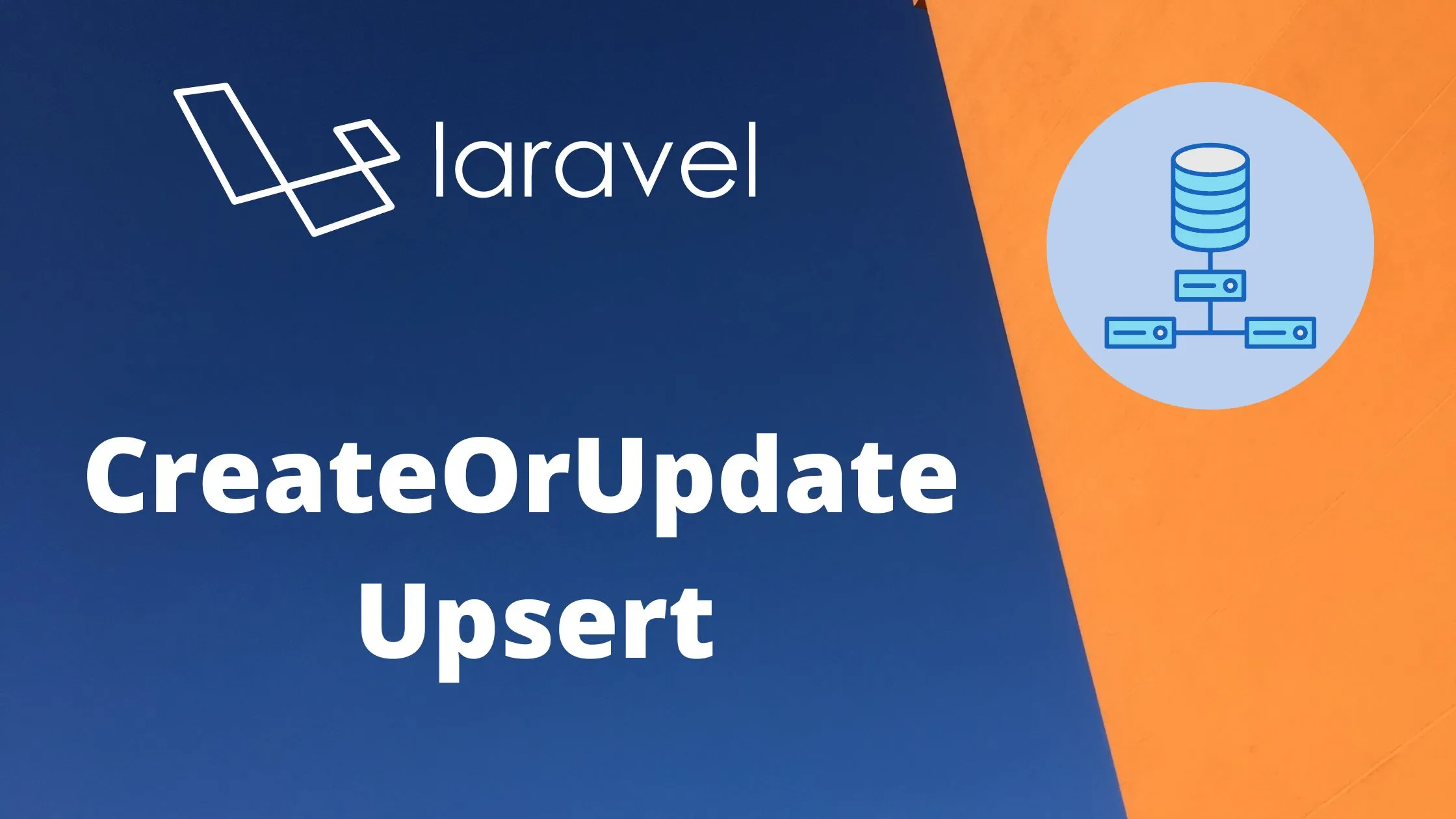Laravel offers a variety of methods for interacting with databases. Among these, the createOrUpdate method, also known as the upsert technique, is a powerful tool that allows developers to streamline their code and improve efficiency. This article provides an in-depth look at the createOrUpdate method, its usage, and its advantages, along with practical use cases and examples.
What is Upsert?
Upsert is a portmanteau of “update” and “insert”. It’s a method used in database management where a row is either updated if it already exists or inserted if it doesn’t. Laravel provides the createOrUpdate method to perform this operation, which can be a significant time-saver and can help keep your codebase clean and efficient.
createOrUpdate Method Signature
The createOrUpdate method in Laravel has the following signature:
public static function updateOrCreate(array $attributes, array $values = []);
$attributes: An array of attributes that Laravel will use to find a record in the database. This is often a unique identifier, such as an email address or user ID.$values: An array of values that Laravel will use to update the record if it exists, or to create a new record if it doesn’t.
How Does createOrUpdate Work in Laravel?
The createOrUpdate method in Laravel attempts to find a model matching the attributes passed as the first parameter. If a matching model is found, it updates the match with the attributes passed as the second parameter. If no matching model is found, a new model is created with both the constraints passed as the first parameter and the attributes passed as the second parameter.
Here’s a simple example of how you might use createOrUpdate:
$user = User::updateOrCreate(
['email' => request('email')],
['name' => request('name')]
);
In this example, Laravel will search for a user with the specified email. If it finds one, it will update the user’s name. If it doesn’t find one, it will create a new user with the given email and name.
Use Cases and Examples
Use Case: User Profile Updates
Consider a web application where users can update their profile information. When a user submits the profile update form, you could use createOrUpdate to either update their existing profile or create a new one if it doesn’t exist:
$profile = UserProfile::updateOrCreate(
['user_id' => Auth::user()->id],
$request->all()
);
In this example, $request->all() is used to get all of the form data. This is a powerful feature of Laravel that allows you to quickly and easily handle form data.
Use Case: Product Inventory Management
Imagine you’re building an inventory management system for a store. When new stock arrives, you could use createOrUpdate to update the inventory for existing products or add new products:
$product = Product::updateOrCreate(
['sku' => $sku],
['quantity' => DB::raw('quantity + ' . $newStock)]
);
In this example, DB::raw is used to increment the quantity of the product in the database. This is a powerful feature of Laravel that allows you to perform raw database queries.
Use Case: Complex Conditions
In some cases, you might need to match a model based on multiple attributes. For example, consider a flight booking system where flights are uniquely identified by their departure and destination airports and departure time:
$flight = Flight::updateOrCreate(
['departure_airport' => $departure
, 'destination_airport' => $destination, 'departure_time' => $departureTime],
['price' => $newPrice]
);
In this example, createOrUpdate is used to update the price of a flight if it exists, or to create a new flight if it doesn’t.
Use Case: Database Seeding
Database seeding is a process where you populate the database with initial data. This data could be for testing purposes or to populate certain database tables with data required for your application to run. Laravel provides a simple way to seed your database with test data using seed classes. All seed classes are stored in the database/seeds directory.
Here’s an example of how you might use createOrUpdate in a database seed:
public function run()
{
$users = [
['email' => '[email protected]', 'name' => 'John Doe'],
['email' => '[email protected]', 'name' => 'Jane Doe'],
// ...
];
foreach ($users as $user) {
User::updateOrCreate(
['email' => $user['email']],
['name' => $user['name']]
);
}
}
In this example, createOrUpdate is used to either update the existing users or create new ones if they don’t exist.
Use Case: Batch Importing External Data
createOrUpdate can be extremely useful when you need to import a large amount of data from an external source. For example, you might need to integrate with another application and regularly import data from it. In such cases, createOrUpdate can help you efficiently import data by updating existing records and creating new ones as needed.
Here’s an example of how you might use createOrUpdate to import data from a CSV file:
public function importFromCsv($filePath)
{
$data = array_map('str_getcsv', file($filePath));
foreach ($data as $row) {
User::updateOrCreate(
['email' => $row[0]],
['name' => $row[1], 'age' => $row[2]]
);
}
}
In this example, createOrUpdate is used to either update the existing users or create new ones based on the data in the CSV file. This can be particularly useful for batch operations where you need to import a large amount of data.
Use Case: EDI (Electronic Data Interchange)
EDI is a concept that allows businesses to communicate with each other via electronic means. It’s often used to exchange documents, orders, invoices, and other business transactions. When integrating an EDI system with Laravel, createOrUpdate can be a powerful tool to synchronize data between the systems.
Here’s an example of how you might use createOrUpdate in an EDI integration:
public function syncWithEdiSystem($ediData)
{
foreach ($ediData as $item) {
Product::updateOrCreate(
['sku' => $item['sku']],
['price' => $item['price'], 'stock' => $item['stock']]
);
}
}
In this example, createOrUpdate is used to either update the existing products or create new ones based on the data received from the EDI system. This ensures that your Laravel application’s data is always in sync with the EDI system.
Advantages of Using createOrUpdate
The createOrUpdate method can significantly simplify your code. Without it, you would need to write separate logic for creating and updating records, which can lead to more complex and harder-to-maintain code. With createOrUpdate, you can handle both scenarios in a single, easy-to-read line of code.
Moreover, createOrUpdate can help improve the performance of your application. By reducing the number of queries you need to make to your database, you can potentially speed up your application and reduce the load on your database.
Final considerations
The createOrUpdate method, along with other similar methods provided by Laravel, can help you write cleaner, more efficient code. By understanding and utilizing these methods, you can take full advantage of Laravel’s powerful features and streamline your database operations.
Further Reading
If you’re interested in learning more about Laravel’s database operations, consider exploring the following topics:
Eloquent ORM: Laravel’s Eloquent ORM provides a beautiful, simple ActiveRecord implementation for working with your database. Each database table has a corresponding “Model” which is used to interact with that table.
Database Migrations: Migrations are like version control for your database, allowing your team to modify and share the application’s database schema definition.
Database Seeding: Laravel includes a simple method of seeding your database with test data using seed classes. All seed classes are stored in the
database/seedsdirectory.Query Builder: Laravel’s database query builder provides a convenient, fluent interface to creating and running database queries. It can be used to perform most database operations in your application.
Remember, Laravel is a powerful and flexible framework that can greatly simplify your web development process. By understanding and utilizing its features, you can create robust, efficient web applications.




Comments